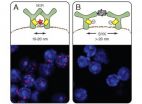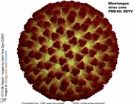(Press-News.org) PROVIDENCE, R.I. [Brown University] — Wrinkles, creases and folds are everywhere in nature, from the surface of human skin to the buckled crust of the Earth. They can also be useful structures for engineers. Wrinkles in thin films, for example, can help make durable circuit boards for flexible electronics.
A new mathematical model developed by researchers from Brown University could help engineers control the formation of wrinkle, crease, and fold structures in a wide variety of materials. It may also help scientists understand how these structures form in nature. The work is published in the Proceedings of the Royal Society A.
"In nature, solid materials often have stiffer surfaces and a more compliant substrate underneath. We call that stiff surface the 'stiffness boundary layer,'" said Kyung-Suk Kim, professor of engineering at Brown, who performed the research with research associate Mazen Diab. "If you have that kind of system and you compress it, it begins to buckle and form many different patterns on the surface."
Those structures include wrinkles, creases, ridges, and folds. In a paper published last year, Kim and Diab cataloged the formation of these structures — they dubbed them "ruga" states — in a theoretical model of a rubbery solid. With this latest paper, they model the transition points between these structures as materials with a stiffness boundary layer are compressed — looking in particular at the transition from wrinkle to crease.
The model shows that at low compression, wrinkles begin to form across the surface. But as compression increases, the model identifies critical points at which groups of ripples suddenly disappear from the surface to form a single crease — a sharp depression where the stiff surface plunges down into the substrate. Knowing that point of creasing, called localization, is critically important for many applications, Kim said.
One example is in flexible electronics. Circuit elements in flexible devices are made on thin films. Those films are usually made of metal, which means they break if stretched. To prevent that, engineers place wrinkles initially into their films. Those wrinkles give the film room to stretch a bit without breaking — like a spring. But if those films are too soft and compressed too much, the wrinkles will localize into a crease. "If you get a crease into the substrate, the film will break," Kim said. "So circuit reliability is related to this localization process."
Kim and Diab also modeled the extent to which localization is reversible. In other words, once a crease forms in a material, how does it uncrease when compression is relaxed? They found that the compression level required to create a crease is different from what is required to undo it.
"If you have a crease and then you relax your strain a little bit, the wrinkles don't come back right away," Kim said. "It keeps its crease shape. We showed that you need a much more relaxed state to get the wrinkles back."
In addition to helping engineers, Kim hopes the model that he and Diab have created will help scientists understand compression processes in natural systems as well. Human skin has a stiffness boundary like the theoretical material Kim and Diab modeled. So the model may offer insights into how wrinkles and creases form in skin and could help in designing artificial skins and soft robot grips. The human brain is covered in wrinkles and creases. Perhaps models like this, Kim says, can shed light on how compression causes brain injury.
"We are laying down the mathematical framework for understanding how this works," Kim said.
INFORMATION:
The work was supported by the Korea Institute of Science and Technology, the Korea Institute of Machinery and Materials, and the U.S. National Science Foundation (DMR-0520651). END
Mathematical models explain how a wrinkle becomes a crease
2014-06-25
ELSE PRESS RELEASES FROM THIS DATE:
Nanoscale ruler reveals organization of the cell membrane
2014-06-25
This news release is available in German.
After a ten-year effort, Prof. Dr. Michael Reth from the Institute of Biology III of the University of Freiburg and the Max Planck Institute of Immunobiology and Epigenetics has developed a method to investigate the cell surface's organization on a nanometer scale. This allows him to monitor how the antigen receptor, which B cells of the immune system use to recognize foreign substances, changes after activation. This study shows that the receptor components dissociate from each other– rather than assemble, as previously ...
New study quantifies the effects of climate change in Europe
2014-06-25
If no further action is taken and global temperature increases by 3.5°C, climate damages in the EU could amount to at least €190 billion, a net welfare loss of 1.8% of its current GDP. Several weather-related extremes could roughly double their average frequency. As a consequence, heat-related deaths could reach about 200 000, the cost of river flood damages could exceed €10 billion and 8000 km2 of forest could burn in southern Europe. The number of people affected by droughts could increase by a factor of seven and coastal damage, due to sea-level rise, could more than ...
Using math to analyze movement of cells, organisms, and disease
2014-06-25
Traveling waves model tumor invasion
Cell migration, which is involved in wound healing, cancer and tumor growth, and embryonic growth and development, has been a topic of interest to mathematicians and biologists for decades.
In a paper published recently in the SIAM Journal on Applied Dynamical Systems, authors Kristen Harley, Peter van Heijster, Robert Marangell, Graeme Pettet, and Martin Wechselberger study a model describing cell invasion through directional outgrowth or movement in the context of malignant tumors, in particular, melanoma or skin cancer. Tumor ...
Freedom of choice: When rejection and discrimination hinder minority entrepreneurs
2014-06-25
When it comes to The American Dream, freedom of choice is a central value for entrepreneurs. According to a new study in the Journal of Consumer Research, when a person's choices are limited due to rejection and discrimination, they are more likely to fail at business and in their personal lives.
"Not only does restricting a person's choices threaten the success of a new business, it also has swift and damaging effects on the individual's self-esteem and their personal sense of control and power in the world," write authors Sterling A. Bone (Utah State University), Glenn ...
Money in the bank: Why does feeling powerful help people save more?
2014-06-25
In a materialistic culture, saving money is a challenge many of us face long before our retirement years. While many people think education, upbringing, and self-control are major contributors to a person's savings habits, a new study in the Journal of Consumer Research reveals that people save more when they feel powerful.
"We were interested in knowing whether the decision to save or not save money was affected by how someone was feeling during the time they were making a savings decision," write authors Emily N. Garbinsky (Stanford University), Anne-Kathrin Klesse ...
Army leads collaborative effort to establish standards for sequencing viral genomes
2014-06-25
Scientists at the U.S. Army Medical Research Institute of Infectious Diseases (USAMRIID) have proposed a set of standards aimed at developing a common "language" among investigators working to sequence viral genomes and characterize viral stocks.
According to USAMRIID senior author Gustavo Palacios, Ph.D., the proposed system, published last week as an editorial in the journal mBio, is the result of a collaborative effort involving scientists from many of the world's leading institutions. Contributors include the Broad Institute, the J. Craig Venter Institute, Los Alamos ...
Achieving Your Goals: Does removing yourself from the big picture help?
2014-06-25
Consider the case of the adult student attending night school to earn a degree that will result in a better job with higher pay. From sacrificing time with friends and family to missing a relaxing evening watching TV, this type of long-term gain often comes with short-term pain. According to a new study in the Journal of Consumer Research, people are more likely to achieve their goals and avoid temptations when they are able to remove themselves from the big picture.
"Past research on personal achievement has focused on whether someone sets nearsighted or farsighted ...
Distorting the past: Why do impulsive consumers forget their past indulgences?
2014-06-25
Activities like dieting, saving money, and studying require goal setting and self-control. But even the most disciplined person falls prey to temptation every once in a while. According to a new study in the Journal of Consumer Research, people who distort past memories of their indulgences are more likely to indulge in the future.
"We investigated the possibility that individuals may distort memories of past behavior in order to allow for indulgence in the present. In other words, people may trick themselves into thinking something like, 'I've been good on my diet lately, ...
Downside to disaster relief: Why do photos of attractive children backfire?
2014-06-25
When it comes to asking a stranger for help, being young, pretty, and the opposite sex greatly improve your odds. But when it comes to children suffering from the likes of natural disaster, poverty, or homelessness, a new study in the Journal of Consumer Research reveals that less attractive children receive more help than their cuter counterparts.
"Many charitable organizations use children in advertising and promotional materials. Our research examines how the facial attractiveness of the children in these campaigns affects the empathy and help received from adults," ...
Double standard? The use of performance-enhancing products
2014-06-25
When professional athletes are found to be using performance-enhancing drugs, many people consider this an unfair advantage and say they are cheating. But when another person uses the same drug to overcome a disease or behavioral issue, society is more forgiving. A new study in the Journal of Consumer Research shows that people are more forgiving when the benefit is personal.
"Our research shows that when people see others using ability-boosting products, they are more likely to see this behavior as morally unacceptable than if they were using the products themselves," ...


